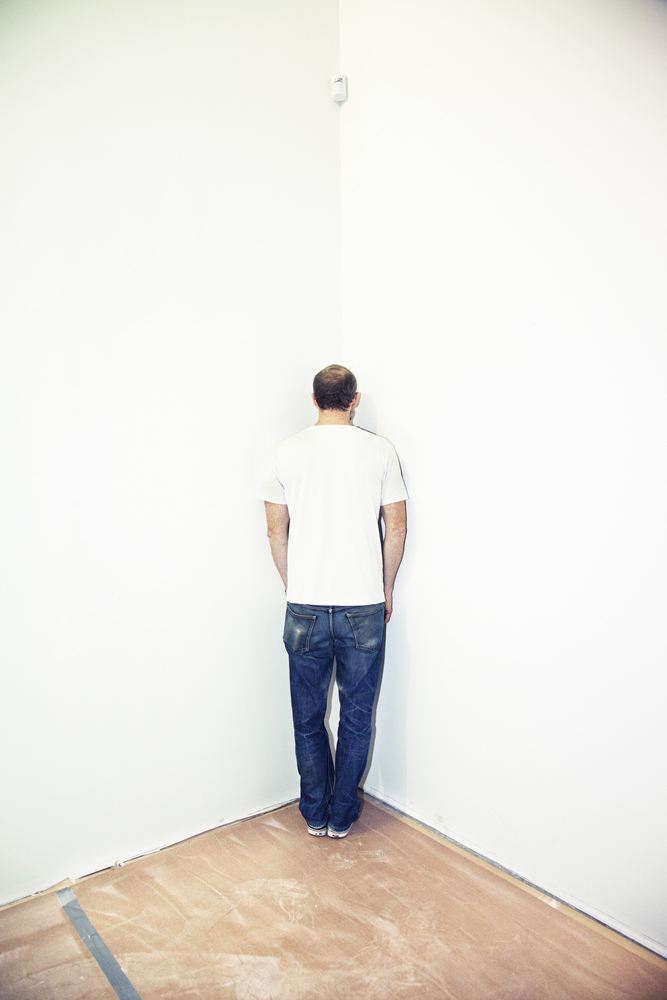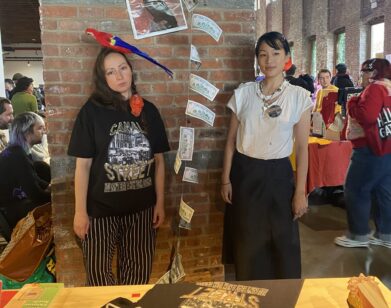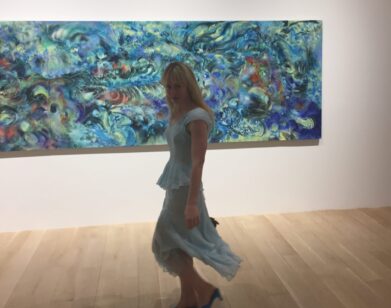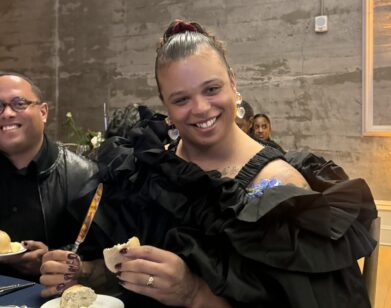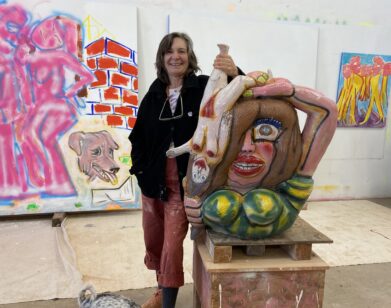Mike Bouchet’s Consumer Fantasies
The finer details of global consumerism can be mind-boggling, not to mention bleak, but Mike Bouchet has learned to embrace them. The Frankfurt-based artist has spent his career examining consumer culture and its limitless products. Drawn to images that viscerally tug at him, Bouchet explores his own emotional response to the quotidian marketing blitz. What results is a whimsical mixed bag: cola, porn, and celebrity-inspired Jacuzzis are the subjects he deals with in “Flood” at Marlborough Chelsea, opening today. The show is Bouchet’s first New York solo exhibition in eight years, and his first with the gallery.
Fittingly, it’s all strategically branded to Bouchet’s liking. The cola is his own concoction, Cola Lite, which is essentially Coca-Cola with no sweetener, artificial or real. Bouchet invented the formula in 2004, envisioning the dark substance as the equivalent of America’s oil export, a counter to foreign oil. Discovering it worked as paint, he began using it to create watery, caramel-colored compositions. Later, in 2010, he filled up a California pool with the liquid at a compound owned by Paul McCarthy—a feat he will repeat at Hôtel Americano for the opening’s after-party. In the exhibition, the eight cola paintings included deal mostly with advertisement themes. Sheer cotton canvases, roughly the size of billboards and bus stop posters, emulate ads in the real world. Ask For More (2013), which displays the Pepsi slogan 18 times, is unsettlingly plausible (more is always better, right?).
Also on view is a series of misshapen cardboard Jacuzzi sculptures named after celebrities. Their strange, uncomfortable-looking contours, Bouchet explains, are inspired by his mental imaginings of the public figures. Featured are the Olsen Twins (2010), bulky, jagged and purple; Lauren Bush Lauren (2013), red with a narrow recess; and David Kissinger (2012), exposed, black and house-like.
On the gallery’s second floor plays Untitled Video (2011), a mosaic of 10,000 10-minute porn videos downloaded from the Internet. “It was a labor of love,” describes Bouchet. “Well, perhaps that’s not the right term.”
Born in California in 1970, Bouchet moved with his family to rural Spain, near Cadiz, when he was nine. It was after Franco died, and the country’s modernization was stunted. Returning to the states as a teenager, he was shocked at the object-driven, consumer lifestyle. “It was like how you can’t take your eyes off the train wreck,” he remembers. Bouchet never shook his fascination, which he says is still a mix of attraction and repulsion. This has manifested in everything from a 3000 square-foot floating factory-made house for the 2009 Venice Biennale, to Carpe Diem (2004), in which a cascade of customized jeans, manufactured in a Colombian sweatshop, rained from an airplane onto the city of their origin.
We met with Bouchet at Marlborough Chelsea and decided to walk to a nearby café. We started talking about shopping, and then malls, and transitioned to suburbia.
MIKE BOUCHET: I grew up in suburbia, in California. When I was nine, my family moved to a very rural spot of southern Spain for four years.
RACHEL SMALL: That must have been beautiful.
BOUCHET: It’s less beautiful now. It’s really gotten trashed, turned into a wasteland. When I moved to Spain, it was not long after Franco died. My stepfather was working for the Spanish-U.S. Navy as a technician. There was kind of a lag period for Spain. There was no television. There was one really crappy Spanish national television program. We didn’t have a television set. There were very few cars. And it was a real big switch at a very impressionable age for me. When I went back to the U.S., it was really kind of a shock—this blend of fascination and repulsion that I think still influences all my work. I had a strong reaction to suburbia. This immediate realization that: “Wow, this is weird. I think America’s the weirdest place in the world.” In particular, the dream of a suburb is still one of the big dreams of the world. Having your own house, your own patch of land. No neighbors crowding in on you. But the reality of it you see in larger cities like Los Angeles, Sacramento. You see the whole cycle where something starts out nice and then social entropy happens. People keep spreading out, kind of, letting other things decay. I still drive through suburbs and new suburbs. I think of them as almost psychedelic.
SMALL: You’ve been living in Frankfurt since 2004. How is the experience of consumerism there?
BOUCHET: I still find bus stops with crazy images and magazines and television. Every commercial project, every marketing campaign, it’s geared for international. They want billions of consumers.
SMALL: It’s also something that appeals to everybody. Like, a picture of a woman drinking Coca-Cola.
BOUCHET: There’s a lot of basic human buttons. What are people’s reactions to things? I do feel as if my buttons are being pressed. If I feel my buttons being pressed, I generally start making work about something. I take material from when I feel like: What do these things want from me? What is this pulling me? From that, it kind of widens to maybe a larger designation. I have my own hypotheses and theories, you know. They’re not very scientific or academic. I have a gut feeling. I think that the commodity aesthetic has a huge affect on our culture, as human beings. I think it’s almost like a monumental force for human beings all over the planet right now.
SMALL: Your clothes, a lot of your food. It’s all brands.
BOUCHET: And there’s layers. Like with some people you speak with [about products they buy], there’s no irony in the discussion. I think Japan doesn’t have much of a sense of irony about these things. And people in Germany wholeheartedly explain why they like this sort of coffee is better and why they like this brand or this type of voice recorder.
SMALL: You can obviously gauge the quality of something. And that’s supposedly consumer autonomy.
BOUCHET: It’s the world’s favorite pastime, is window-shopping. Where it gets dark and kind of meaner—where I think it becomes problematic—is the tendency to instill a kind of anxiety or fear in people of, like, “Oh, that’s last year’s tie.” Or knowingly making a tape recorder that will break in five years. These kind of things to keep people, kind of—
SMALL: On their toes.
BOUCHET: —or slightly nervous about things, I find it discomforting. But, other than that, there’s lots of amazing things to share with what’s available in the world right now. I try to use this in a positive way in my work, in that, I get to participate, you can participate, too. I got jeans made by a place in Colombia. I made my own cola.
SMALL: Where did the idea to make your own brand of come from?
BOUCHET: Well, I wanted to make my own Diet Coke.
SMALL: Why diet?
BOUCHET: I like the kind of thing about diet. It’s like the guilty pleasure. It’s somehow a restraint, but then you drink five. There’s all these ladies, like, diet is somehow a futuristic concept and to say, “Yeah, we’re going to make something that’s not bad for you, but here’s the experience of the bad thing.” But, then maybe it’s worse. It gets very complicated once you introduce diet. In mine, there’s no sugar or artificial sweetener in it. But then it’s still diet.
SMALL: It must taste terrible.
BOUCHET: It tastes interesting. You can taste it and really understand what cola is. It’s a bit of a deconstruction.
SMALL: So, what’s in it? Or is it like a secret?
BOUCHET: No, it’s not a secret at all. The cola recipe was never really a secret. There are eight different kinds of oils. It’s like lime, orange, lemon, cassia. There’s a type of lavender. I forget everything that’s in it. Then they mix it with gum arabic so the oils can dissolve into water. Caffeine, citric acid, phosphoric acid. I went to a pharmacy and we experimented until I got it. And then I called an essence laboratory. This is another thing: essence laboratories are a huge monopoly. There’s three companies that make all the flavors and smells for the whole world. Of perfumes, foods. It’s very secretive.
SMALL: It’s strange to think about how that determines our sensory experience of taste and smell.
BOUCHET: What you think of as a strawberry color and taste has been manipulated a lot. It’s like the idea of strawberry. It’s probably related to your childhood notions.
SMALL: Why use soda in your art?
BOUCHET: The largest advertising campaign and marketing budget in the world is for Coca-Cola. I think what’s interesting is the notion of a stimulus, a relief, is somehow bottled in that. I’m interested in it for a number of reasons. One is, it’s America’s oil export. All that base oil leaves America in a very concentrated form. Every country has its own bottle. It goes to these places and it’s mixed according to the taste of each country. Mexico has the most sugar with their Coke. All of this base oil is leaving America. Black gold. And it’s leaving and then it’s refined for every country. It’s the opposite of how oil comes here. You know, it leaves like crude oil from, and we expand it here. They do the same thing over there. So I like the visual image of the planet with all this stuff going one way and also going the other.
SMALL: It’s also an interesting way to brand yourself as an artist—just use this one type of paint. It’s an interesting parallel to the branding of Coca-Cola. You’re using this medium again and again.
BOUCHET: I like that. For me, the definition of an artist is cultural producing. When I read about the idea, I realized I could produce like everyone else, you know?
SMALL: There have, of course, been a lot of artists that explore consumer culture. How do you think your artwork treats it differently or departs from the past?
BOUCHET: I think that with all those artists, there’s an aspect of trying to understand the time they’re living in. The same applies for me. An important notion for me is about exploring right now. It’s not so much about nostalgia and looking back. I think that for sure those artists are working from that too. I think that I’m less interested in the straightforward aesthetic of the information. Appropriation is a given in our time. My work is more of a kind of subjective interpretation of information. When people say, sometimes, “Oh, is it appropriation art?” I say, “No. I’m a misappropriation artist.” I like this idea of customizing and rendering something worthless or dysfunctional. I take a lot of pleasure out of this: conflating things until they don’t work. The idea of making products that fail in a consumer situation, but are interesting in an artistic situation. I think that the art world in this respect is still an amazing place. That you can make these things that have no practical use. Or even aesthetic. But you still appreciate it. When I’m making Jacuzzis, I’m always thinking about how one’s body would be positioned. Maybe there’s points of comfort, maybe there’s awkwardness. You conceptualize yourself in those weird spaces. Then the colors are subjective to the name of the Jacuzzi who I meant it for. They are noncommissioned commissions. I’ll look at the shape and I’ll think, “Hm,” like, “Sylvester Stallone.” It’s not about the person. It’s about the idea of the person.
SMALL: What about the video?
BOUCHET: It’s titled The Untitled Video. It’s the first untitled work I’ve made. It’s composited from 10,000 porno videos that were downloaded off the Internet and 10,000 porno videos playing simultaneously in a big mosaic. I was thinking about the amount of pornography on the Internet and what that means for video art. There’s been a lot of work that’s dealt with video, and I’ve seen a lot of video art that’s dealt with pornography. Somehow I kind of had this vision of the river passing me by. I have taken this big bucket and dipped it into this river of information—all of this pornography.
SMALL: Is it just chaos?
BOUCHET: It’s not chaotic. There’s definitely a general skin tone. Formal qualities. The overall video becomes this, kind of, flicker-y, geometric grid. It has a weird push-pull optical effect. You get into a trance. There’s no sound. It’s ten minutes of a collective desire. A lot of people don’t realize that’s what it is when they see it. There’s something about the activity, the motion—people who realize they, kind of, grab onto.
SMALL: “Flood” at Marlborough Chelsea is your first solo show in New York in eight years. Can I ask what the significance of that is for you, coming back?
BOUCHET: I do think that New York is still the most important place in the world for the exhibition of art. And for me, it’s important to make work in America. My work deals with what? Consumerism. International perspective. A lot of those ideas were coming from America, originally.
SMALL: What do you want people to take away from the show?
BOUCHET: On a very simple level—it sounds romantic—but I would hope that they take away the notion of taking information in, their impressions of the world, and seeing that I’ve tried to turn them into something beautiful. It is about my own, individual methodology. And [at the same time] we can appreciate everybody’s individual impressions of the world around them. I would also hope people feel inspired to go and make art. That’s the most I can ask for as an artist. It makes me want to make work on a simple level. I think that’s a tremendous thing that art can do. And bring some other type of understanding of the world.
“FLOOD” OPENS TODAY AT MARLBOROUGH CHELSEA, AND WILL BE ON VIEW THROUGH NOVEMBER 9.

